Architecture Home Styles
How Long Do Wooden Frame Houses Last? Maintenance Guide
Peek into the secrets of wooden frame house longevity and discover the key to preserving these architectural treasures for generations to come.
In the realm of wooden frame houses, longevity can be likened to a well-tended garden blooming year after year. Picture this – a century-old timber frame house standing strong amidst changing seasons, a testament to meticulous care and attention.
But how does one ensure such durability and resilience? Let's explore the secrets behind the extended lifespan of wooden frame houses, unraveling the maintenance guide that holds the key to preserving these architectural wonders for generations to come.
Key Takeaways
- Choose decay-resistant woods like cedar and oak for longevity.
- Prioritize regular maintenance, inspections, and protective coatings.
- Opt for high-quality construction techniques and durable materials.
- Implement a diligent maintenance routine for extended lifespan.
Lifespan of Wooden Frame Houses
Wooden frame houses, when properly maintained, exhibit impressive durability, with some structures lasting over 100 years. The longevity of timber frame houses stems from the inherent strength of the frame itself. Timber, when used in construction, provides a robust and stable frame that can withstand the test of time.
Maintenance plays a crucial role in prolonging the lifespan of wooden frame houses. Regular upkeep, such as inspecting for rot, addressing pest issues, and applying protective coatings, helps safeguard the frame against environmental elements. To protect the frame from moisture, which can lead to decay, proper ventilation and drainage systems are essential.
Additionally, periodic inspections for any signs of wear and tear allow for timely repairs, ensuring the structural integrity of the frame. By adhering to a comprehensive maintenance schedule, homeowners can maximize the longevity of their wooden frame houses and enjoy a durable and resilient living space for generations to come.
Wood Type Considerations

When considering the longevity of wooden frame houses, the type of wood selected plays a critical role. Factors such as timber selection tips, rot resistance, and the availability of sustainable wood options are vital considerations.
Understanding the properties and characteristics of different wood types is essential for making informed choices that can impact the durability of a timber frame structure.
Timber Selection Tips
In timber frame construction, the selection of the wood type plays a crucial role in determining the longevity and durability of the structure. When choosing the timber for your frame, consider the following tips:
- Strength Matters: Opt for wood species like oak known for their strength and ability to support the structure over time.
- Resistance to Decay: Select woods like cedar that offer natural resistance to decay, reducing the risk of structural damage.
- Maintenance Requirements: Consider the maintenance needs of the wood type chosen; some woods, like pine, may require more upkeep to ensure longevity.
- Durability Factors: Evaluate the overall durability of the wood species to ensure it can withstand environmental stresses and maintain its integrity.
Rot Resistance Factors
Hardwoods such as oak and cedar exhibit greater resistance to rot compared to softwoods like pine in timber frame construction. When considering wood species selection for timber frame construction, it's essential to prioritize rot resistance to ensure the longevity and durability of the structure.
Proper maintenance, including regular inspections and treatment, can further enhance the rot resistance of the wood used. By choosing rot-resistant wood species and implementing a diligent maintenance routine, the risk of decay in wooden frame houses can be significantly reduced.
Understanding the properties of different wood types and their impact on rot resistance is crucial for maintaining the structural integrity of timber frame constructions over time.
Sustainable Wood Options
Prioritizing sustainable wood options for timber frame construction is essential to ensure the longevity and durability of wooden frame houses. When considering wood type for construction, the following options stand out for their durability and eco-friendly characteristics:
- Cedar and Redwood: Naturally durable and resistant to decay.
- Douglas Fir: Known for its strength and stability.
- Oak: Valued for its strength and durability in long-lasting structures.
- Accoya Wood: Offers enhanced durability and stability, making it a reliable choice for timber frame construction.
Selecting from these sustainable wood options such as cedar, redwood, Douglas fir, oak, and Accoya wood ensures the construction of robust and long-lasting timber frame houses.
Construction Quality Impact

High-quality construction techniques play a vital role in determining the longevity of wooden frame houses. The use of durable materials and proper structural integrity are key factors that can significantly impact the lifespan of these structures.
Attention to detail during construction, including precise assembly and foundational strength, is essential for ensuring the durability of wooden frame homes.
Material Durability Factors
When considering the material durability factors that impact the construction quality of wooden frame houses, the type of wood used, the construction techniques employed, and the maintenance practices implemented play critical roles in determining the lifespan of the structure.
The type of wood, such as cedar or redwood, can significantly impact the longevity of the house.
Utilizing sturdy beam construction and traditional timber frames enhances the structural integrity.
Regular treatments with wood bleach can protect against decay and rot, extending the life of the wooden frame.
Shielding the wood from direct exposure to UV rays through finishes or coatings helps prevent weathering and deterioration.
Structural Integrity Importance
To ensure the longevity and structural integrity of wooden frame houses, meticulous attention to construction quality is paramount. The construction quality of timber frame houses significantly impacts their durability and ability to withstand the test of time. Incorporating traditional woodworking joints like mortise and tenon for joining large wooden beams and posts can enhance the structural integrity of the house. Modern wooden frame houses are designed with lighter framing members and insulated panels, contributing to improved longevity. Regular maintenance, including thorough inspections for moisture, pests, and decay, is essential for preserving the structural integrity of wooden frame houses. By prioritizing construction quality and addressing any issues promptly, wooden frame houses can last over 100 years with proper upkeep.
| Construction Quality | Impact on Structural Integrity |
|---|---|
| Traditional woodworking joints | Enhance durability |
| Modern design techniques | Improved longevity |
| Regular maintenance | Crucial for preservation |
Common Maintenance Issues
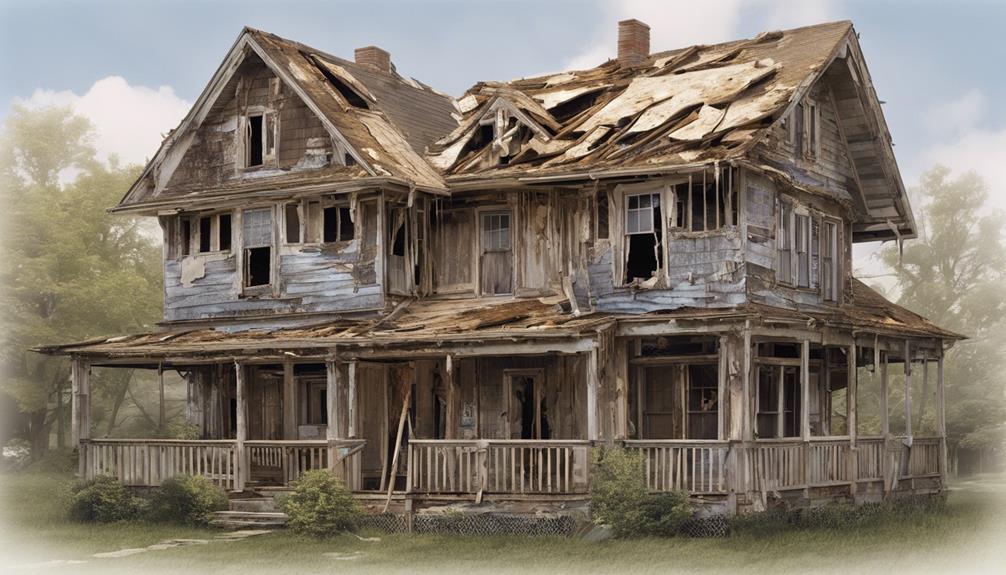
Regular inspections for moisture, pests, and decay play a crucial role in preventing common maintenance issues in wooden frame houses. To ensure the longevity of timber frame homes, it's imperative to keep a close eye on potential threats. Here are some common maintenance issues to watch out for:
- Moisture Intrusion: Even the smallest leaks can lead to significant damage over time. Regularly check for water infiltration to prevent decay and mold growth.
- Pest Infestation: Insects and rodents can cause extensive harm to the structural integrity of a wooden frame house. Implement pest control measures to safeguard against infestations.
- Fungal Growth: Fungi thrive in moist environments and can compromise the stability of heavy timber components. Treat any fungal growth promptly to prevent back decay.
- Crack Sealing: Small cracks may seem inconsequential, but they can allow moisture and pests to infiltrate the wood. Seal cracks to maintain the integrity of the structure.
Preventative Maintenance Measures
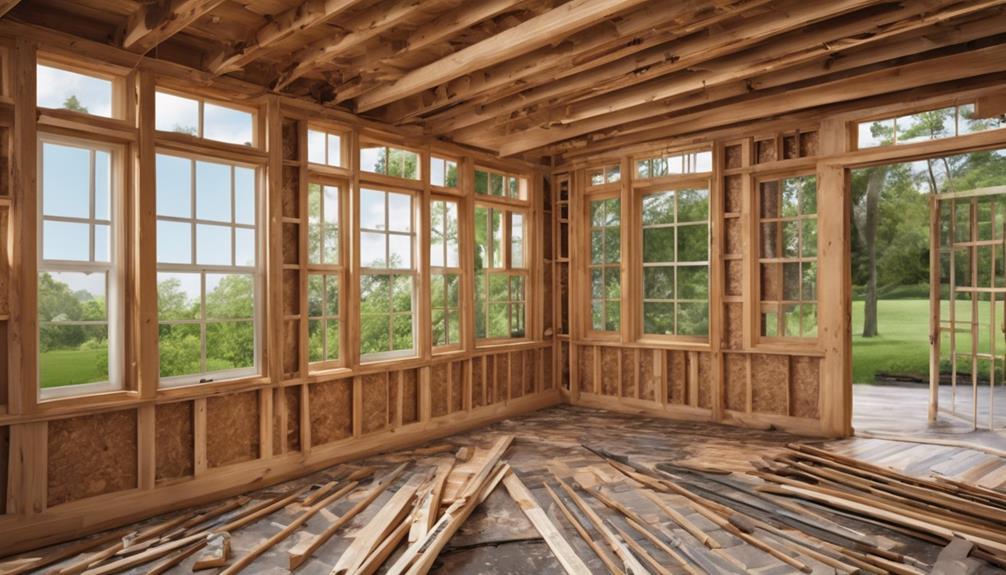
Implementing preventative maintenance measures is crucial for preserving the longevity and structural integrity of wooden frame houses. To protect your investment, consider using stainless steel or aluminum plates strategically in timber frame construction to prevent cracks and ensure stability.
Additionally, installing roof gutters and large overhangs can shield the wooden frame structure from water damage and weathering. Opting for UV-blocking glass windows helps minimize sun damage, extending the lifespan of the timber frame house.
Applying insecticide and fungicide preventatively can deter pests and fungal growth that may compromise the wooden frame. When designing, choose features that enhance structural durability and prevent decay in the timber frame construction.
Longevity of Historic Examples
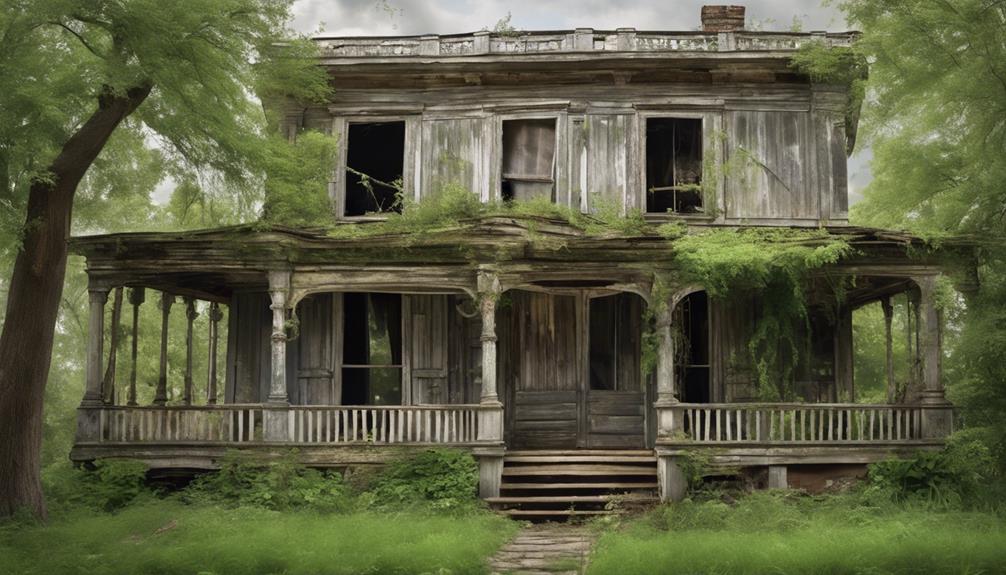
Europe's timber frame structures have demonstrated remarkable longevity, with some lasting over 400 years. These historic examples showcase the lasting quality and resilience of timber structures when proper maintenance is upheld.
The Barley Barn in England, standing since 1270, serves as a testament to the enduring nature of timber frame construction. Similarly, the inhabited Fachwerkhäuser structures in Germany from the 14th century highlight the longevity achievable with timber frames.
Japan's Hōryū-ji temple, built in 607, stands as the world's oldest timber building, emphasizing the exceptional lifespan of timber structures when well-cared for. These historic examples worldwide underscore the significance of proper maintenance in extending the lifespan of timber frame houses, proving that with attention to upkeep, these structures can endure for centuries.
Exterior Maintenance Guide

To ensure the longevity of wooden frame houses, a diligent exterior maintenance routine is essential. Regularly inspecting the exterior timber for changes in color or texture allows for early detection of maintenance needs. When the exterior stain begins to fade, it's crucial to reapply the stain promptly to protect the wood from weathering. Choosing a high-quality stain that repels water and UV rays helps to safeguard the exterior timber from environmental damage.
Additionally, applying an extra top coat of stain every 4-5 years is recommended to uphold the wood's appearance and durability over time. In cases where the timber has weathered significantly, using wood bleach to revitalize it before applying a new coat of stain can provide a fresh and rejuvenated look. By following these practices for exterior wood maintenance, including reapplying stain and ensuring UV protection, the wooden frame house can remain in optimal condition for an extended period.
Interior Maintenance Guide
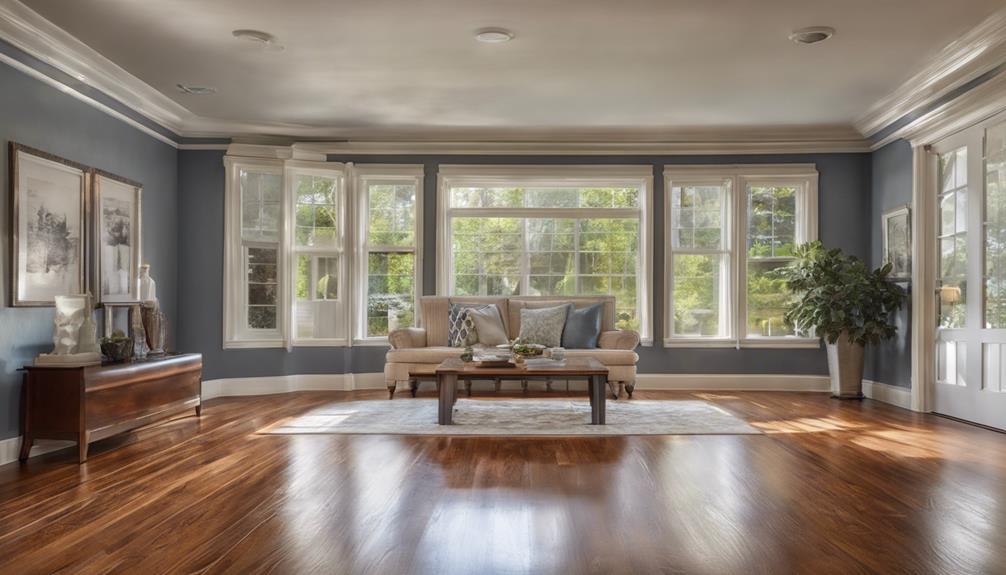
Regularly maintaining the interior wood of a wooden frame house is crucial for preserving its structural integrity and aesthetic appeal over time. To ensure the longevity of the interior wood, consider the following maintenance guidelines:
- Use Water-Based Stain: Apply a water-based stain every 5-6 years to preserve the timber frame effectively without compromising its natural beauty.
- Monitor Humidity Levels: Maintain indoor humidity levels around 40% to prevent the wood from drying out or absorbing excess moisture, safeguarding it against warping or rot.
- Enhance Ventilation: Proper ventilation throughout the house is essential to prevent humidity-related issues within the timber frame, promoting a healthier environment for the wood.
- Regular Inspections: Inspect the interior wood regularly for any signs of wear, discoloration, or damage. Addressing maintenance needs promptly can prevent minor issues from escalating and ensure the wood remains in optimal condition.
Frequently Asked Questions
What Is the Lifespan of a Wood Frame House?
Wood frame houses can last over 100 years with proper maintenance. Some historic timber structures have stood for centuries, like Japan's Hōryū-ji temple from 607.
In Europe, buildings like the Barley Barn from 1270 and Germany's Fachwerkhäuser from the 14th century are still in use. These examples demonstrate the longevity of well-maintained wooden frame constructions, showcasing the durability and potential of this building style.
What Are the Disadvantages of a Wood Frame House?
Wood frame houses present unique disadvantages, such as:
- Increased fire risk
- Vulnerability to moisture and insect damage
- The need for regular maintenance to combat rot and decay
These factors can lead to higher insurance premiums and structural issues like warping and settling over time.
Despite these challenges, innovations in construction materials and techniques continue to address and mitigate these drawbacks, ensuring the longevity and safety of wooden frame structures.
How Long Does Framing Wood Last?
Framing wood longevity depends on multiple factors. Properly engineered and maintained wood can last 50+ years in stable climates. Historical timber frame buildings have lasted over 500 years with care. Wood species, drying methods, and climate impact durability.
Good maintenance, material selection, and design enhance longevity. Understanding these factors is crucial for maximizing the lifespan of framing wood in innovative ways.
How Do You Maintain a Timber Frame?
Maintaining a timber frame is crucial for longevity. Are we proactive in inspecting for moisture, pests, and decay?
We must control humidity levels between 30-50%. Timely repairs for leaks and moisture are vital. Seal cracks, treat fungus, and consider preservatives for protection. Ventilation or dehumidifiers help control moisture.
Our efforts will preserve the timber frame's integrity and extend its lifespan.
Conclusion
In conclusion, it can be said that the longevity of wooden frame houses, when properly maintained, is truly impressive. By adhering to a comprehensive maintenance guide and taking necessary preventative measures, these structures can stand the test of time.
The subtle art of preservation ensures that these homes continue to thrive and age gracefully, showcasing the beauty and resilience of timber frame construction.
- About the Author
- Latest Posts
Introducing Ron, the home decor aficionado at ByRetreat, whose passion for creating beautiful and inviting spaces is at the heart of his work. With his deep knowledge of home decor and his innate sense of style, Ron brings a wealth of expertise and a keen eye for detail to the ByRetreat team.
Ron’s love for home decor goes beyond aesthetics; he understands that our surroundings play a significant role in our overall well-being and productivity. With this in mind, Ron is dedicated to transforming remote workspaces into havens of comfort, functionality, and beauty.
Architecture Home Styles
Strong Yet Light: 7 Metals That Strike the Perfect Balance
Witness the captivating dance of strength and lightness as seven metals reveal their secrets in 'Strong Yet Light' – a journey you won't want to miss.

Titanium, aluminum, magnesium – these metals not only symbolize strength but also embody the elusive quality of lightness that engineers strive for.
As we navigate through the intricate world of materials, the quest for the perfect balance between strength and weight becomes paramount.
The interplay of these seven metals in various applications holds secrets waiting to be uncovered, promising a deeper understanding of their potential.
Key Takeaways
- Titanium offers exceptional strength and lightness, ideal for aerospace and medical applications.
- Aluminum combines lightweight properties with corrosion resistance, perfect for various industries.
- Magnesium provides high strength-to-weight ratio and heat resistance, suitable for aerospace and automotive sectors.
- Scandium forms strong, corrosion-resistant alloys, driving innovation in high-performance sports equipment and other industries.
Titanium
Titanium stands out as a prime choice in industries requiring a combination of strength, lightness, and corrosion resistance. With its high strength-to-weight ratio, titanium strikes the perfect balance between durability and weight savings. This characteristic makes it a top contender in applications where performance is paramount. Its corrosion-resistant properties further enhance its appeal, particularly in aerospace, medical implants, and sports equipment.
The low density of titanium, comparable to aluminum, belies its exceptional durability and toughness. This metal's biocompatibility adds to its versatility, allowing for use in surgical implants and prosthetics without fear of adverse reactions. Its superior strength and lightness make it a popular choice for high-performance and durable products across various industries. Whether in the air, in the human body, or on the sports field, titanium's perfect balance of properties continues to drive innovation and excellence.
Aluminum

Aluminum, renowned for its lightweight nature and exceptional corrosion resistance, serves as a versatile metal with a wide range of applications across industries such as aerospace and construction. With a density approximately one-third that of steel, aluminum offers a favorable strength-to-weight ratio, making it a go-to choice for applications where weight reduction is critical. Its malleability and ductility allow for intricate shaping and forming, enabling the production of complex designs. Additionally, the metal's good electrical conductivity makes it a suitable material for electrical transmission lines and components.
Noteworthy is aluminum's sustainability aspect; it's one of the most recycled metals, with nearly 75% of all aluminum ever produced still in use today. This recyclability not only reduces the demand for primary aluminum but also minimizes energy consumption in the production process. As industries continue to seek lightweight, durable, and corrosion-resistant materials, aluminum stands out as a key player meeting these demands while also contributing to a more sustainable future.
Magnesium
Magnesium's lightweight nature, with a density of 1.738 g/cm³ and a tensile strength of 240 MPa, offers unparalleled versatility in various industries. Its high strength-to-weight ratio makes it a sustainable choice for structural applications, while its corrosion resistance adds to its durability.
The metal's excellent machinability and heat resistance, with a melting point of 650°C (1202°F), further highlight its suitability for intricate designs and applications in aerospace, automotive, and electronics.
Lightweight Versatility of Magnesium
With its exceptional strength-to-weight ratio, magnesium stands out as the premier choice for lightweight applications in various industries. Weighing approximately 30% less than aluminum, magnesium is the lightest structural metal available.
This characteristic, coupled with its high strength-to-weight ratio, makes it an ideal material for components requiring reduced weight without compromising on strength. Magnesium alloys find extensive use in aerospace, automotive, and electronic industries due to their lightweight and durable properties.
Despite its low density, magnesium showcases excellent mechanical characteristics, including good stiffness and impact resistance. Alloying can further enhance magnesium's corrosion resistance, increasing its versatility for a wide range of engineering applications where lightweight versatility is paramount.
Sustainable Properties of Magnesium
Considered a sustainable metal due to its recyclability and biodegradable properties, magnesium offers a lightweight and durable solution for various industrial applications. Magnesium's recyclability rate is approximately 90%, making it an environmentally friendly choice for industries aiming to reduce waste. Its biodegradable nature further enhances its sustainability profile, particularly in applications such as biodegradable implants and medical devices. The lightweight nature of magnesium, with a density of 1.738 g/cm³, provides a significant advantage in weight-sensitive industries like automotive and aerospace. Additionally, its high strength-to-weight ratio makes it ideal for structural applications where durability is crucial. These properties position magnesium as a versatile and eco-conscious material for innovative solutions.
| Sustainable Properties of Magnesium | |
|---|---|
| Recyclability | Approximately 90% |
| Biodegradability | Yes |
| Environmental Impact | Low |
Beryllium

Beryllium is a lightweight metal with exceptional strength-to-weight characteristics. It offers a unique blend of durability and low density. Its high resistance to fatigue and superior thermal conductivity make it a preferred choice in demanding aerospace and defense applications.
Despite its advantages, caution must be exercised due to potential health hazards associated with beryllium exposure.
Lightweight and Durable
Striking the perfect balance between lightweight design and exceptional durability, beryllium stands out as a top choice for industries requiring high-performance materials.
- Beryllium's low density, approximately one-third that of steel, makes it ideal for applications prioritizing weight reduction without sacrificing strength.
- Despite its lightweight nature, beryllium exhibits exceptional strength and stiffness, ensuring structural integrity in demanding environments.
- With a high melting point of 1,287°C, beryllium can withstand elevated temperatures and harsh conditions while maintaining its superior properties.
This unique combination of lightweight characteristics and robustness positions beryllium as a preferred material in aerospace, defense, and medical equipment industries, where performance and reliability are critical for driving technological advancements.
Unique Properties of Beryllium
Beryllium's unique properties set it apart as a standout material in high-performance industries due to its exceptional stiffness, low density, high melting point, non-magnetic characteristics, transparency to X-rays, and excellent thermal conductivity. Its status as the lightest alkaline earth metal with a density less than water, combined with the highest melting point among light metals exceeding 1,287 degrees Celsius, makes it an ideal choice for aerospace and defense applications. The table below highlights some key characteristics of beryllium:
| Property | Description |
|---|---|
| Density | Less than water |
| Melting Point | Exceeds 1,287°C |
| Applications | Aerospace, defense |
Innovators in various industries turn to beryllium for its exceptional properties, driving advancements in technology and engineering.
Scandium

Scandium, a rare earth metal with atomic number 21 and symbol Sc, is highly valued for its lightweight and high-strength properties in various industries.
- Lightweight Advantage: Scandium's low density makes it a top choice in aerospace applications, where weight reduction is critical for fuel efficiency and performance enhancement.
- Strength in Alloys: When combined with aluminum, scandium forms strong and corrosion-resistant alloys. These alloys find applications in high-performance sports equipment like baseball bats and bicycle frames.
- Technological Applications: Due to its high melting point and excellent strength-to-weight ratio, scandium is utilized in advanced technologies such as high-intensity discharge lamps and fuel cells, contributing to the efficiency and reliability of these systems.
Scandium's unique properties make it a sought-after material in industries that require a balance between strength and weight. Its versatility in alloy formations and technological applications continues to drive innovation in various sectors.
Lithium

Having discussed Scandium's valuable properties in balancing strength and weight in various industries, the focus now shifts to Lithium, a metal renowned for its lightweight nature and critical role in modern technology and energy storage solutions. Lithium stands out as the lightest metal and the least dense solid element, attributed to its incredibly low atomic weight. This characteristic makes lithium highly desirable in applications where weight reduction is crucial.
Not only is Lithium exceptionally lightweight, but it also possesses high reactivity and flammability, qualities that are harnessed in the production of batteries for their energy storage capabilities. Beyond its role in batteries, lithium finds essential uses across diverse industries such as pharmaceuticals, ceramics, and aerospace. Its unique properties make it a vital component in cutting-edge technology and innovative energy storage solutions. As we delve deeper into the realm of metals that strike the perfect balance between strength and weight, the significance of Lithium in pushing the boundaries of modern innovation becomes even more apparent.
Titanium Aluminides
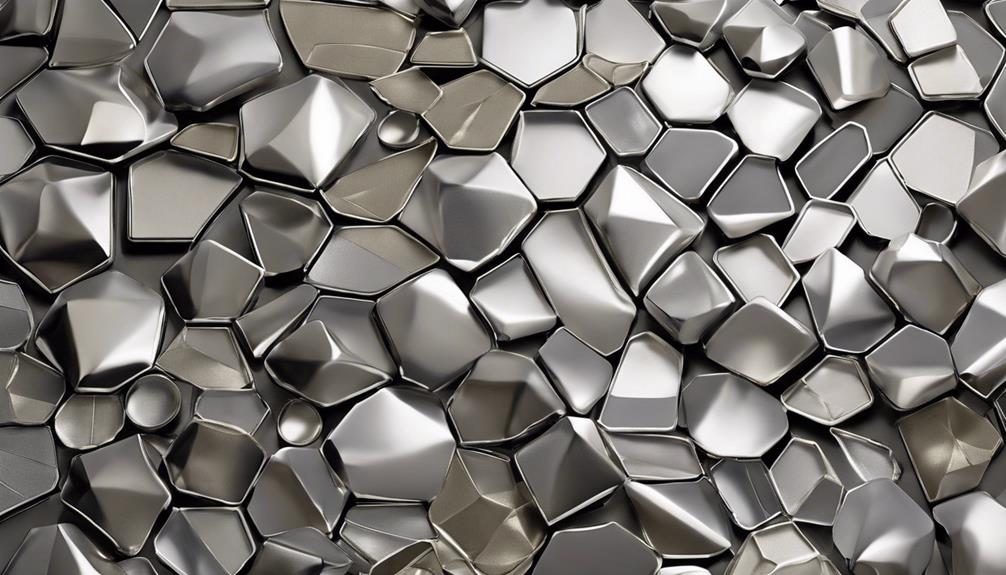
Titanium aluminides, characterized by their exceptional strength-to-weight ratio, are intermetallic compounds composed primarily of titanium and aluminum. The allure of these materials lies in their unique properties that make them highly desirable for various industries.
- High-Temperature Stability: Titanium aluminides exhibit remarkable stability at elevated temperatures, making them ideal for applications in aerospace where components are subjected to extreme heat conditions. This property ensures the integrity and longevity of the material under demanding thermal environments.
- Oxidation Resistance: Another key feature of titanium aluminides is their excellent resistance to oxidation. This resistance to oxidation is crucial for maintaining the structural integrity and performance of the material over time, especially in aerospace and automotive applications where exposure to oxygen is unavoidable.
- Superior Mechanical Properties: The microstructure of titanium aluminides plays a vital role in enhancing their mechanical properties. This unique structure contributes to their exceptional strength, stiffness, and fatigue resistance, making them a preferred choice for lightweight, high-strength applications.
Frequently Asked Questions
How Do the Properties of Titanium Compare to Those of Other Metals Like Aluminum and Magnesium?
When comparing titanium to metals like aluminum and magnesium, we find that titanium offers a unique balance of strength and lightness.
Titanium boasts a higher strength-to-weight ratio compared to aluminum and magnesium, making it an excellent choice for applications requiring both durability and low weight.
Additionally, titanium exhibits exceptional corrosion resistance and biocompatibility, further enhancing its appeal in various industries.
These properties make titanium a valuable and versatile material for innovative solutions.
Are There Any Unique Applications for Beryllium in Industries That Require Strong yet Light Materials?
Absolutely, beryllium possesses exceptional qualities that make it valuable in industries seeking strong yet lightweight materials. Its high strength-to-weight ratio, rigidity, and thermal conductivity are unparalleled.
In aerospace, beryllium is utilized for its ability to maintain structural integrity while reducing overall weight, crucial for aircraft and spacecraft design. Additionally, its non-magnetic properties are advantageous in sensitive equipment like MRI machines.
Beryllium's unique attributes make it a standout choice in various cutting-edge applications.
What Are the Potential Drawbacks or Limitations of Using Scandium in Manufacturing Processes?
When considering the potential drawbacks of using scandium in manufacturing processes, we must acknowledge its high cost and limited availability. These factors can significantly impact the feasibility of widespread adoption in various industries.
Additionally, the challenges associated with extracting and refining scandium further contribute to its limitations. Despite its remarkable properties, such as lightweight and strength, these obstacles need to be carefully weighed when evaluating the practicality of utilizing scandium in manufacturing.
How Does the Cost of Using Lithium in Metal Alloys Compare to Other Lightweight Metals?
When comparing the cost of using lithium in metal alloys to other lightweight metals, we find that lithium tends to be more expensive due to its limited availability and extraction complexities.
Despite its desirable properties, such as low density and high strength, the higher cost of lithium can be a limiting factor in certain manufacturing processes.
However, advancements in technology and production methods may help mitigate these cost challenges over time.
Are There Any Safety Concerns Associated With Working With Titanium Aluminides in Industrial Settings?
When it comes to titanium aluminides in industrial settings, safety concerns are minimal. These alloys have been meticulously engineered to withstand extreme conditions while remaining lightweight.
Our team has extensively researched the properties and behaviors of titanium aluminides, and we can confidently say that they pose no significant risks when handled properly. Trust in our expertise, and rest assured that working with titanium aluminides is a safe and efficient choice for your industrial needs.
Conclusion
In conclusion, the comparison of metals such as titanium, aluminum, and magnesium reveals their unique balance of strength and lightness.
An interesting statistic to note is that titanium has the highest strength-to-density ratio of any metallic element, making it a preferred choice in aerospace and medical applications.
This exploration of metal properties not only deepens our understanding of material behavior, but also paves the way for innovative advancements in various fields.
- About the Author
- Latest Posts
Introducing Ron, the home decor aficionado at ByRetreat, whose passion for creating beautiful and inviting spaces is at the heart of his work. With his deep knowledge of home decor and his innate sense of style, Ron brings a wealth of expertise and a keen eye for detail to the ByRetreat team.
Ron’s love for home decor goes beyond aesthetics; he understands that our surroundings play a significant role in our overall well-being and productivity. With this in mind, Ron is dedicated to transforming remote workspaces into havens of comfort, functionality, and beauty.
Architecture Home Styles
Exploring Historic Roofing Materials Used in 1900: A How-To Guide
Mysteries of the past await in the intricate world of historic roofing materials from 1900 – uncover secrets and stories that will leave you captivated.
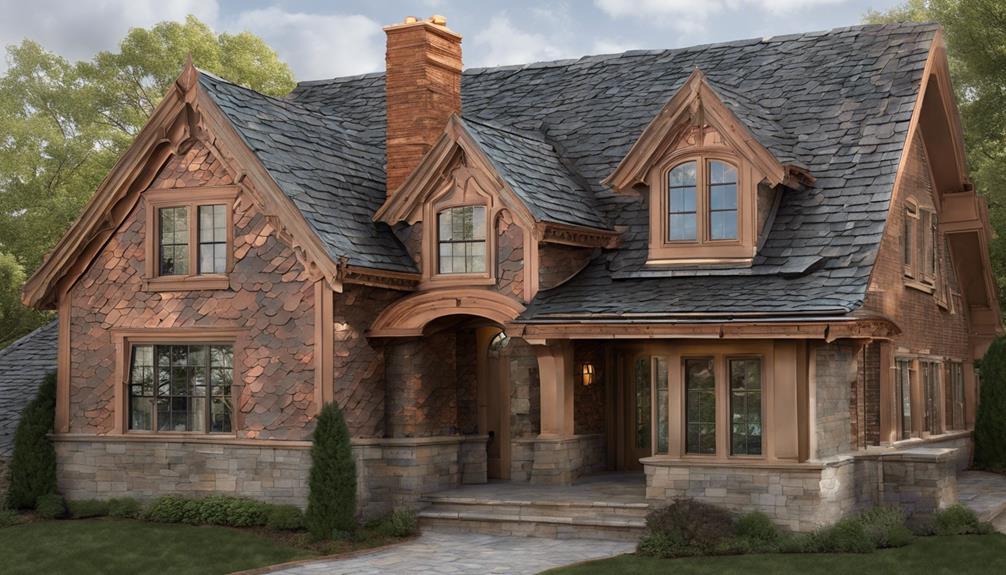
In the realm of historical architecture, the roofs of yesteryears symbolize more than just overhead protection; they embody a connection to our past and a reflection of craftsmanship long forgotten.
As we journey through the landscape of roofing materials used in 1900, we uncover a tapestry woven with wood, clay, slate, metal, and asphalt. Each material tells a story of resilience and tradition, offering a glimpse into a world where authenticity and sustainability reign supreme.
Join us as we unravel the secrets of these historic roofs, where every tile, shingle, and slate holds a piece of history waiting to be discovered.
Key Takeaways
- Preserve authenticity by using clay tiles, slate, wood shingles, or metal roofing.
- Understand historical context for accurate restoration of early 1900s buildings.
- Consult experts to match roofing materials with architectural styles of the era.
- Follow preservation guidelines to showcase construction techniques and cultural significance.
Overview of Historic Roofing Materials
In the realm of historic roofing materials in 1900, a diverse array of options like clay tiles, slate, wood shingles, and metal roofing prevailed, marking an era of evolution and craftsmanship. Clay tiles, known for their durability and distinctive appearance, were a popular choice for roofing material in historic buildings. Slate, prized for its elegance and longevity, adorned many roofs of the time, adding a touch of sophistication to American buildings. Wood shingles, with their rustic charm and natural appeal, were commonly used in the countryside, blending seamlessly with the landscape. Metal roofing, a versatile option gaining popularity, offered strength and resilience to withstand the elements.
Craftsmanship played a pivotal role in the installation of these roofing materials, with meticulous attention to detail and expert knowledge of preservation treatments ensuring the longevity of historic roofs. Understanding the craft practices involved in handling these materials was crucial for maintaining the authenticity and charm of the historic buildings. The diverse range of materials used in 1900 reflected the rich heritage and architectural diversity prevalent in American buildings during that time, showcasing a blend of functionality and aesthetics.
Importance of Preserving Historic Roofing

Preserving historic roofing materials from the early 1900s embodies a commitment to safeguarding the architectural legacy and cultural significance of our heritage. When we prioritize the preservation of these roofs, we aren't just maintaining old structures; we're ensuring that the stories and craftsmanship of the past aren't lost to time.
Here are four reasons why preserving historic roofing is essential:
- Maintaining Authenticity: Historic roofing materials help maintain the authenticity of buildings from the early 1900s, allowing us to experience architecture as it was intended.
- Showcasing Construction Techniques: These materials reflect the construction techniques of the time, providing insights into the craftsmanship and skills of earlier builders.
- Preserving Cultural Significance: By conserving historic roofs, we contribute to the overall historical integrity and cultural significance of structures built around 1900.
- Appreciating Design Evolution: Understanding and conserving these materials allow for a deeper appreciation of architectural heritage and the evolution of design over time.
Common Roofing Materials in 1900
Exploring the roofing landscape of 1900 unveils a rich tapestry of materials that shaped the architectural identity of that era. This landscape encompassed wood shingles, clay tiles, slate, metal roofs, and asphalt shingles. Wood shingles, prevalent in rural areas, not only provided a traditional appeal but also were easily accessible.
Clay tiles were sought after for their durability and Mediterranean-inspired aesthetic, adding a touch of elegance to rooftops. Slate roofs, commonly found in the northeastern U.S., stood out for their longevity and timeless charm.
In 1900, metal roofs crafted from lead, copper, or tin gained popularity due to their durability and exceptional fire resistance, offering peace of mind to homeowners. Each material carried its own unique characteristics, contributing to the diverse architectural styles and preferences of the time. This created a mosaic of roofing options that reflected both practicality and aesthetics.
Techniques for Restoring Historic Roofs

Restoring historic roofs demands a meticulous approach that honors the original materials and craftsmanship while prioritizing historical accuracy and preservation. When undertaking the restoration of a historic roof, several key techniques should be considered to ensure an authentic and accurate restoration process:
- Understand the Historical Context: Delve into the historical context of the roof's construction to grasp the techniques and materials used during that time period.
- Document Before Restoration: Proper documentation is crucial before commencing restoration work to preserve the historical integrity of the roof for future generations.
- Replicate Traditional Techniques: Skilled roofers should replicate traditional techniques to maintain the authenticity of the historic roof, ensuring that the craftsmanship remains true to its origins.
- Follow Preservation Guidelines: Adhere to preservation guidelines provided by historical organizations to guarantee the accurate restoration of historic roofs, respecting the historical significance of the structure.
Tips for Choosing Authentic Roofing Materials
In selecting authentic roofing materials for historical restoration projects, a thorough understanding of the materials used in the early 1900s is essential to ensure historical accuracy and preservation. To assist in choosing the right materials, consider the following tips:
| Authentic Roofing Materials | Tips for Selection |
|---|---|
| Clay Tiles | Check regional preferences and availability in 1900. |
| Slate Shingles | Research historical documents for accurate sourcing. |
| Wood Shingles | Consider preservation guidelines for authentic replicas. |
| Metal Roofing | Consult experts to match materials to architectural style. |
Frequently Asked Questions
What Roofing Material Was Used in 1900?
In 1900, a variety of roofing materials were commonly used. Wood shingles were favored for their availability and timeless look. Clay tiles, especially in Mediterranean-inspired architecture, were prevalent.
Slate roofs, a premium choice, boasted durability and elegance. Metal roofs, like lead and copper, were chosen for their longevity and weather resistance. Each material had its unique benefits, catering to different needs and architectural styles during that period.
What Were the Types of Roofing in the 19th Century?
In the 19th century, various roofing materials adorned buildings. Wood shingles, clay tiles, slate, and metal roofs were common choices.
Wood shingles were prevalent in wood-rich areas, while clay tiles offered a distinct aesthetic. Slate, though rare, stood out for its durability and elegance. Metal roofs, crafted from lead, copper, and tin, provided enduring protection.
These materials reflected both practicality and style in the 19th-century construction landscape.
What Is the History of Roofing Materials?
We've delved into the history of roofing materials, uncovering a tapestry of evolution. From ancient thatch to modern asphalt shingles, each era has left its mark.
Understanding this journey offers a window into human ingenuity and architectural progress. Our exploration reveals how materials like wood, clay, slate, and metal have shaped civilizations, with regional nuances reflecting diverse traditions.
The history of roofing materials is a testament to our adaptability and creativity throughout the ages.
What Were the Ancient Roofing Methods?
Ancient roofing methods varied across civilizations and regions. Thatch, wood, clay, stone, slate, and tiles were commonly used materials for roofing structures.
Thatched roofs dominated Western Europe before wooden shingles gained popularity. The ancient Greeks, Romans, and Chinese utilized slate, tile, and clay for roofing purposes. King John of England even promoted the use of clay roofs during his reign.
The evolution of roofing materials reflects the ingenuity and adaptability of past societies.
Conclusion
As we journeyed through the past and explored the diverse array of roofing materials used in 1900, we uncovered a treasure trove of history and craftsmanship that continues to inspire us today.
Like a patchwork quilt of tradition and innovation, these materials weave together the stories of our ancestors and the enduring beauty of historic homes.
Let's embrace the legacy of our roofs, preserving their charm and character for generations to come.
- About the Author
- Latest Posts
Introducing Ron, the home decor aficionado at ByRetreat, whose passion for creating beautiful and inviting spaces is at the heart of his work. With his deep knowledge of home decor and his innate sense of style, Ron brings a wealth of expertise and a keen eye for detail to the ByRetreat team.
Ron’s love for home decor goes beyond aesthetics; he understands that our surroundings play a significant role in our overall well-being and productivity. With this in mind, Ron is dedicated to transforming remote workspaces into havens of comfort, functionality, and beauty.
Architecture Home Styles
What Is the Best Grade of Asphalt Shingles for Durability?
Delve into the world of asphalt shingles and discover why the best grade for durability might surprise you – it's more than just longevity!
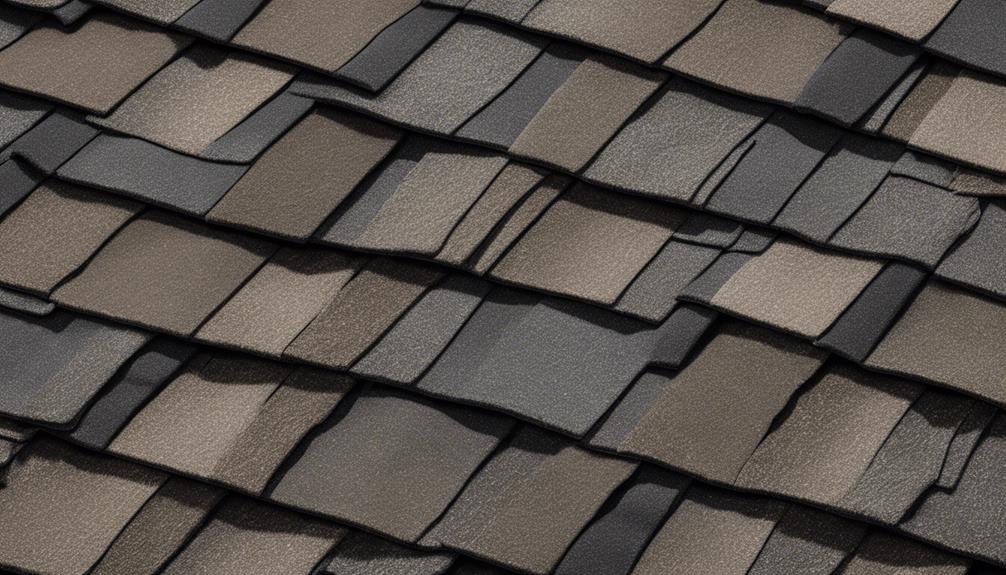
When assessing the best grade of asphalt shingles for durability, one intriguing fact emerges: premium shingles can significantly impact the longevity of your roof. Their robust construction and enhanced aesthetics make them a compelling choice for homeowners seeking a long-term roofing solution.
But what sets these luxury shingles apart from the rest, and how do they fare against other grades in terms of performance and endurance? Let's explore the nuances of asphalt shingle grades and uncover the key factors that determine their durability.
Key Takeaways
- Premium grade asphalt shingles offer exceptional longevity, lasting over 40 years.
- Opt for TruSlate GAF shingles for top-tier roofing durability.
- Premium shingles replicate natural slate and cedar shake roofs for aesthetic appeal.
- Investing in premium options ensures superior durability, performance, and longevity.
Grades of Asphalt Shingles
When evaluating grades of asphalt shingles, it's essential to consider the balance between affordability and durability offered by each class. The different grades available in the market cater to varying needs and preferences.
Starting with good grade asphalt shingles, commonly known as 3-tab shingles, they strike a balance between cost-effectiveness and durability, often accompanied by a class A fire rating.
Moving up the ladder, better grade architectural shingles offer enhanced texture, thickness, and a longer warranty period of approximately 30 years, making them a popular choice for those seeking longevity in their roofing material.
Durability Factors to Consider

Considering the weight and asphalt content of asphalt shingles is crucial when evaluating their durability and longevity. The weight of shingles impacts their wind resistance and overall robustness. Heavier shingles, typically in the premium or designer grade range at around 450 lbs per square, offer superior durability, lasting up to 38-60 years while also resisting algae growth and staining.
Shingles with higher asphalt content provide enhanced waterproofing and longevity. Opting for architectural shingles within the mid-grade category, weighing around 240-250 lbs per square, can significantly improve durability and lifespan. By understanding these factors, one can select shingles that offer the best balance of strength and longevity.
It's important to prioritize the quality and grade of asphalt shingles to ensure long-term protection for your roof.
Best Grade for Longevity
To ascertain the best grade of asphalt shingles for longevity, one must prioritize premium or luxury options known for their extended lifespan and superior durability. Premium asphalt shingles, such as those designed to replicate the appearance of natural slate and cedar shake roofs, offer exceptional longevity, lasting upwards of 40 years. These high-quality shingles not only enhance the aesthetic appeal of a property with their multi-dimensional texture but also provide top-notch durability and performance. One notable option to consider is TruSlate GAF shingles, which ensure a high-quality roofing solution. These premium shingles are engineered to meet stringent quality standards, ensuring that your roof can support the load and installation requirements for long-lasting protection.
| Premium Asphalt Shingles Features | Longevity | Durability |
|---|---|---|
| Natural Slate Appearance | High | High |
| Cedar Shake Replication | High | High |
| Multi-Dimensional Texture | High | High |
Performance and Durability Comparison

In assessing the performance and durability of asphalt shingles, one must carefully evaluate their structural integrity and resistance to environmental factors. Premium grade shingles, such as TruSlate GAF options, stand out for their exceptional durability and longevity, lasting over 40 years. These premium shingles not only offer longevity but also provide superior performance, mimicking the appearance of natural slate and cedar shake roofs.
While premium shingles excel in both durability and aesthetics, their installation may pose challenges requiring professional expertise to ensure proper setup. When considering the best grade of asphalt shingles for durability, the premium options like TruSlate GAF stand as top choices for those seeking a high-quality roofing solution that combines longevity, performance, and visual appeal. By opting for premium grade asphalt shingles, homeowners can enhance the durability and lifespan of their roofs while enjoying the benefits of a premium-grade product.
Choosing the Most Durable Grade
When evaluating the most durable grade of asphalt shingles, prioritize premium or designer options known for lasting 38-60 years with enhanced resistance to environmental factors.
Premium shingles, weighing 450 lbs per square, not only provide longevity but also enhance the street appeal of your roof. The best grade of asphalt shingles offers superior resistance to impact and weather elements, ensuring long-term durability and protection for your home.
While the initial investment in premium asphalt shingles may be higher, the extended lifespan and savings in the long run make them a wise choice. Understanding the quality and durability of premium grade asphalt shingles is crucial for making a sustainable investment in your roof.
Frequently Asked Questions
What Is the Best Grade of Asphalt Shingles?
We believe the best grade of asphalt shingles combines premium quality with exceptional durability. These shingles, often designer or premium grade, offer superior performance and longevity.
With a weight of 450 lbs per square, they can last 38-60 years and resist algae growth and staining. This high-grade option not only provides durability but also replicates the aesthetic appeal of natural slate and cedar shake roofs, ensuring a long-lasting and stylish roofing solution.
What Shingles Last the Longest?
When considering longevity, the best shingles are those designed to withstand the test of time. Premium asphalt shingles, boasting a lifespan of 30+ years in ideal conditions, are the top choice for durability.
Their resistance to storm damage, algae growth, and staining make them a smart investment for long-term roofing needs.
Opting for premium or designer shingles ensures both longevity and aesthetic appeal, providing peace of mind for years to come.
What Are the Best Shingles for Longevity?
When it comes to longevity, premium or designer asphalt shingles weighing 450 lbs per square stand out. Offering exceptional durability and lasting 38-60 years, they resist algae growth and staining.
Though pricier, these shingles enhance style, durability, and curb appeal, withstanding harsh weather conditions. Opting for premium asphalt shingles ensures a longer lifespan, reducing the need for frequent repairs or replacements.
Their superior quality makes them a wise investment for long-term roofing solutions.
What Is the Best Quality Roofing Shingles?
When considering the best quality roofing shingles, premium or designer shingles stand out for their exceptional durability and aesthetic appeal. These shingles, such as TruSlate GAF, offer longevity, resistance to algae, and an attractive multi-dimensional texture that replicates natural slate and cedar shake roofs.
It's crucial to ensure your roof structure can support the heavier weight of premium shingles. Despite the higher cost, the investment in premium shingles pays off with style and long-lasting durability.
Conclusion
In conclusion, when considering the best grade of asphalt shingles for durability, premium shingles are the top choice. With their superior longevity and multi-dimensional texture, they offer maximum durability and curb appeal.
For example, a homeowner in a high wind area opted for luxury shingles and experienced no damage during a recent storm, showcasing the resilience and durability of premium shingles.
When investing in your roof, choosing the most durable grade is essential for long-lasting protection.
- About the Author
- Latest Posts
Introducing Ron, the home decor aficionado at ByRetreat, whose passion for creating beautiful and inviting spaces is at the heart of his work. With his deep knowledge of home decor and his innate sense of style, Ron brings a wealth of expertise and a keen eye for detail to the ByRetreat team.
Ron’s love for home decor goes beyond aesthetics; he understands that our surroundings play a significant role in our overall well-being and productivity. With this in mind, Ron is dedicated to transforming remote workspaces into havens of comfort, functionality, and beauty.
-

 Vetted2 days ago
Vetted2 days ago15 Best Printers of 2024: Top Picks and Expert Reviews
-

 Vetted4 days ago
Vetted4 days ago15 Best Tile Sealers for Long-Lasting Protection and Shine
-

 Vetted1 week ago
Vetted1 week ago15 Best Smelling Floor Cleaners That Will Leave Your Home Fresh and Inviting
-

 Vetted6 days ago
Vetted6 days ago14 Best Power Scrubbers for Showers That Will Transform Your Cleaning Routine
-

 Mardi Gras Decoration1 day ago
Mardi Gras Decoration1 day agoWhat Do the Symbols of Mardi Gras Mean?
-

 Appliances4 days ago
Appliances4 days ago5 Best Energy-Efficient Stainless Steel Fridges 2023
-
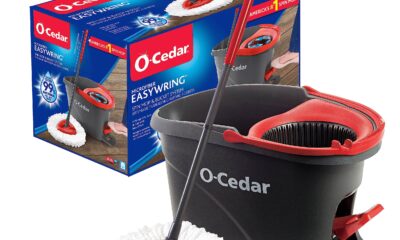
 Vetted4 weeks ago
Vetted4 weeks agoBest Mop for Sparkling Clean Floors in 2024
-
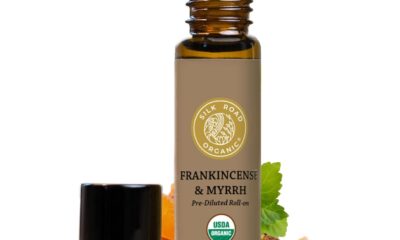
 Vetted4 days ago
Vetted4 days agoBest Essential Oil Brand: Top Picks for 2024









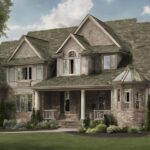


![Best Murphy Bed Options for Small Spaces [2024] 106 81VUhrTjgqL](https://byretreat.com/wp-content/uploads/2023/11/81VUhrTjgqL-80x80.jpg)









![Best Murphy Bed Options for Small Spaces [2024] 121 81VUhrTjgqL](https://byretreat.com/wp-content/uploads/2023/11/81VUhrTjgqL-560x600.jpg)

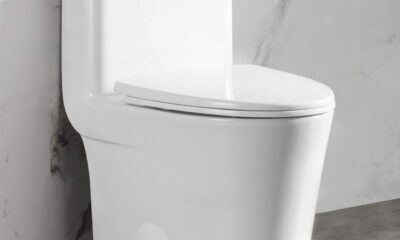

![Best Floor Cleaner for Sparkling Clean Floors [2024] 145 81jJS17Y4IL 2](https://byretreat.com/wp-content/uploads/2023/11/81jJS17Y4IL-2-80x80.jpg)

